Palmer Motor Cycle Tyres, 1913.
Early motorcycles are no stranger to OCC, despite four-wheeled transport making up the majority of the content around here (see this page for a selection of period motorcycle photographs for instance). One of the earliest motorcycle-related items to feature is the booklet shown below. It was produced in 1913, shortly before the outbreak of the Great War (WW1), by the company behind Palmer Motor Cycle Tyres, namely Palmer Cord Tyre Ltd. On its cover is an illustration of a typical motorcyclist of the era, in his riding attire, perched upon a vintage flat-tank motorcycle - possibly a Triumph - fitted, of course, with a set of Palmer Cord Tyres.
|
|
The company was first registered in 1895 according to an online source. While this booklet specifically relates to their motorcycle tyres, the company would also produce tyres for cars and bicycles, and in addition wheels and tyres for aircraft (their Palmer Cord Aero Tyres range). Sales were international, and successes overseas included the winning car of the 1914 Indianapolis 500, a Delage, sporting a set of Palmer Cord tyres. In all, five of the top six finishers used their products.
|
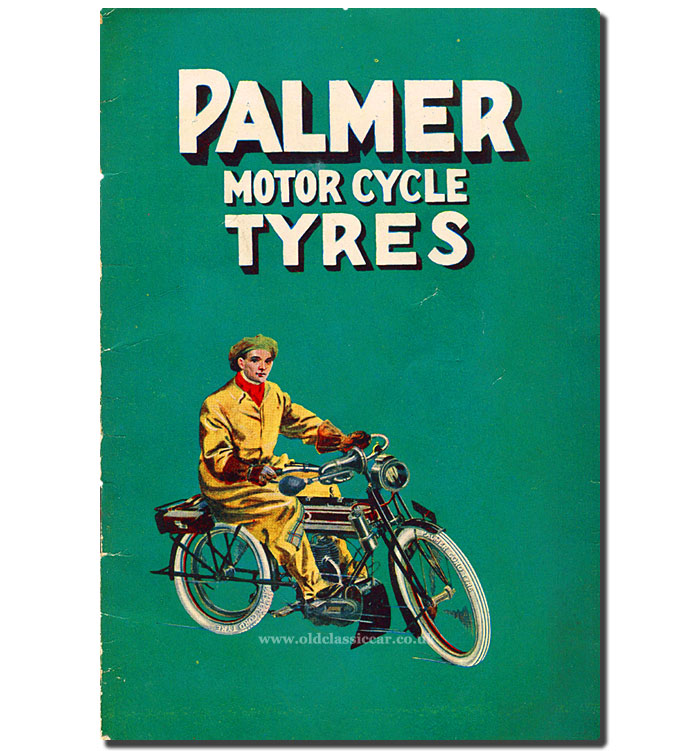
|
|
Inside the front cover, the date for the booklet is given - October 1913 - as is a reference to the fact that Palmer Tyre Limited were official contractors to H.M. War Office and the G.P.O. (Greater Post Office). The company's head office was on Shaftesbury Avenue in London, with their dedicated cycle and motorcycle depot being located on St John Street, Clerkenwell, also in London. Local depots were scattered around Britain, while continental customers were served by branches in Paris and Amsterdam.
|

|
|
Overleaf, there was good news for potential customers ...
|
|
"In presenting Palmer Motor Cycle Tyres to the public, for 1914 season, we are pleased to announce a considerable reduction in price. The consistency of the rubber market enables us to make this reduction. It does not mean any deterioration in materials or workmanship. Constant improvements are being made to give the motor cyclist the best value possible, and we are now able to place upon the market three grades of Palmer Motor Cycle Tyres which, for real good service, cannot be equalled."
|
|
The three tyres offered were as follows: 1. The "Airless" Cord, or "Cord Tyre", 2. the "Palmer Heavy Fabric Tyre", with its four layers of fabric, and 3. the "Palmer Ordinary Fabric Tyre", with two layers. The specific materials that went into each type are then presented over a couple of pages.
|

|
|
A clever feature of their tyres, unique to the company, was a "low tread" signal warning. A thin strip of red rubber was incorporated below the tread, only revealing itself once the tread had worn down to an extent that replacement or re-treading was now due.
|

|
|
There then follows a detailed description of the Heavy Fabric Tyre, and the Ordinary Fabric Tyre.
|
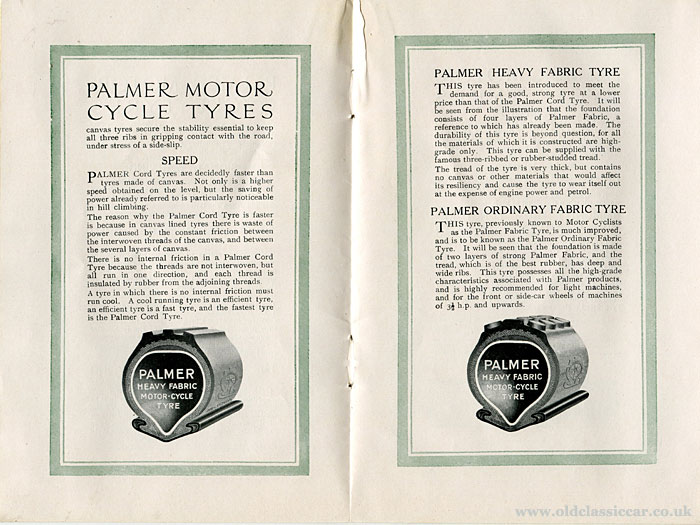
|
|
Further benefits, in terms of ride comfort, cleanliness, and resistance to punctures are then described. The strength of the core also enabled worn tyres to be re-treaded, whereby a new tread would be "vulcanized" onto the old carcas. The virtues of the Palmer Butt Ended inner tubes are also extolled, supported by a glowing report submitted by a happy customer from Hartlepool in May 1911.
|
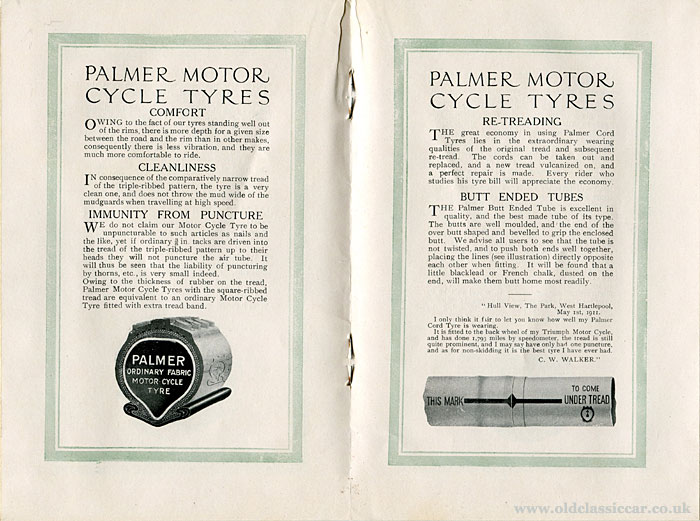
|
No guarantees.
It's interesting to note that the company offered no guarantees for its products. This was typical of the day, motor manufacturers for instance would list within the factory handbook all the companies that supplied components that featured in their vehicles. If anything went wrong, say with a Lucas lamp, the owner was directed to contact Lucas directly, rather than the supplying dealer for the vehicle in question. Very different from the warranties offered today. The next page in the booklet confirms Palmer Tyre's stance on the subject, commencing with the following two paragraphs:
|
|
"The Palmer Tyre Ltd respectfully beg to point out that it is impossible to guarantee Motor-Cycle Tyres, owing to the conditions under which these tyres are used."
|
|
"The greatest care and skill of the Company have been given to the production of its Motor-Cycle Tyres in order to produce the best article on the market - but no responsibility can be accepted for defects of any kind which may exist in the Company's products, nor for any accidents to persons or things which may arise therefrom."
|
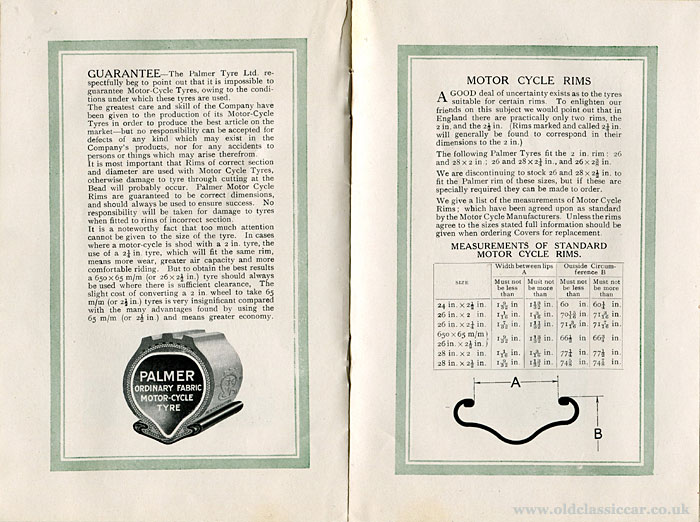
|
Rim types & tyre repair.
Information on motorcycle rim dimensions is then given, as an aid to choosing the correct tyres for one's machine.
|
|
Tips on the successful repair of punctures then follows, including a nod to the company's own repair patches which were designed for the job.
|
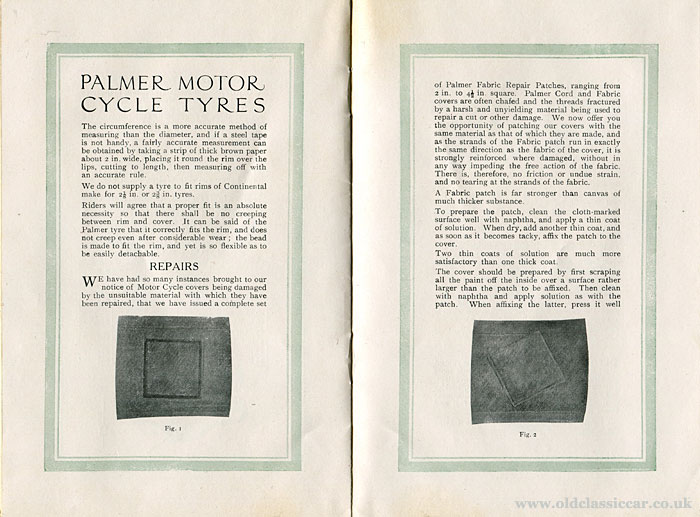
|
|
Further advice designed to simplify the decision-making process when choosing new tyres is given, based on the power of the machine in question. Anyone with a "tradesmen's carrier" would find that the 1.75" "Ordinary Tyre" would be a suitable choice. Another testimonial, received from a gent in Scunthorpe, rounds out the page.
|
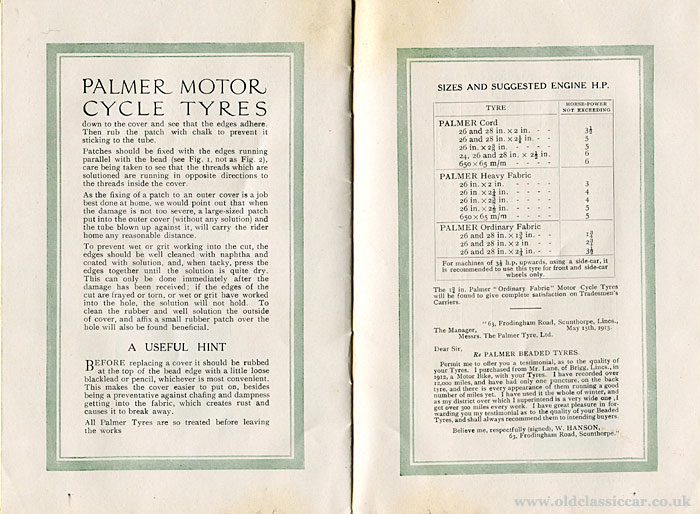
|
|
The final page is given over to prices for the various tyres, tubes, and repair patches that were available to purchase.
|
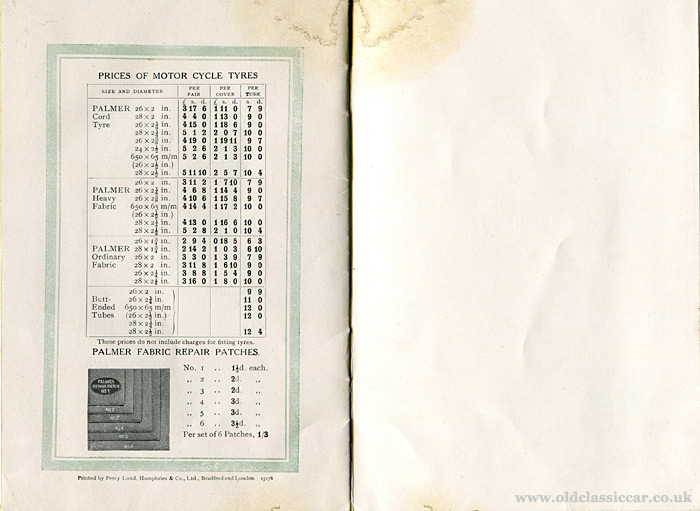
|
|
Return to the Motoring Collectables section for more items relating to pre-war cars and motorcycles. Other literature produced by rival tyre companies in the early years of the 20th Century may also be found on the site. Here, for example, is a publication describing British-made "International" Tyres, from 1919.
|














